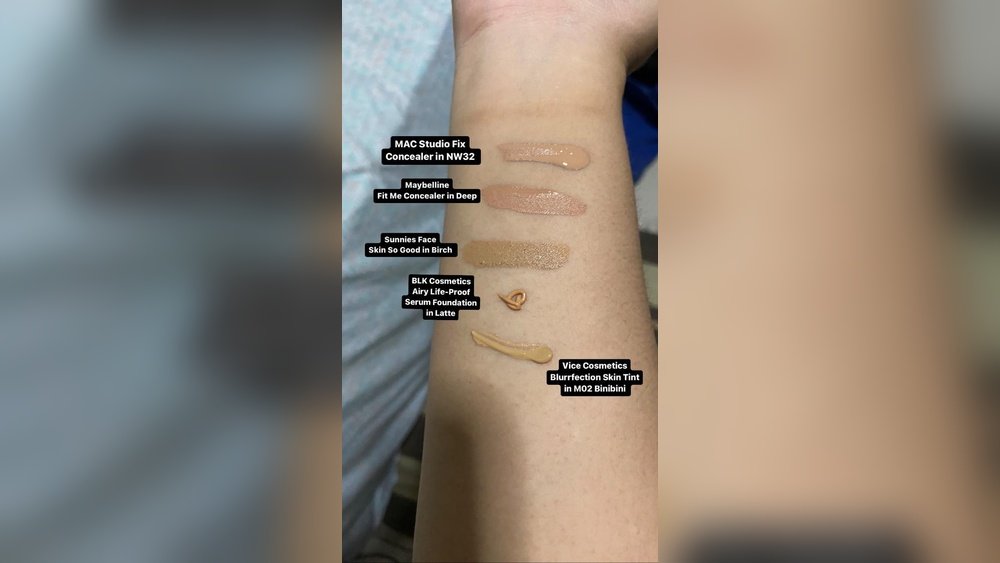Have you ever applied your foundation only to see it turn darker or orange after a few hours? This frustrating change is called oxidation, and it can ruin your perfect makeup look.
But don’t worry—fixing foundation shade oxidation is easier than you think. You’ll discover simple, practical tips to stop your foundation from oxidizing and keep your complexion looking fresh all day. Ready to learn how to protect your makeup and enhance your natural glow?
Let’s dive in!

Credit: www.matchmymakeup.com
Causes Of Foundation Oxidation
Foundation oxidation happens when the product changes color after application. It often turns darker or orange, affecting your makeup look. Understanding the causes helps prevent this problem and keeps your makeup fresh.
Several factors can cause foundation to oxidize. These relate to your skin type, the product’s ingredients, and how you apply your makeup. Knowing these can help you choose the right products and techniques.
Skin’s Natural Oils And Sebum
Oily skin produces more sebum, which reacts with foundation. Sebum can break down the formula and change its color. This reaction speeds up oxidation and affects the finish.
Exposure To Air And Light
Air exposure causes foundation to oxidize. Oxygen reacts with the pigments and oils in the product. Sunlight and artificial light can also speed up this process.
Ingredients In The Foundation
Some ingredients oxidize faster than others. Foundations with certain oils or pigments are more prone to color change. Older products tend to oxidize more due to ingredient breakdown.
Mixing With Other Products
Combining foundation with other skincare or makeup can cause oxidation. Ingredients may interact and alter the foundation’s color. This is common when mixing with moisturizers or sunscreens.
Application Technique
Applying too much foundation can trap oils and air. This creates a perfect environment for oxidation. Using a primer can help protect the skin and reduce this effect.
Choosing The Right Foundation
Choosing the right foundation is key to a flawless look. Many people face issues with foundation shade oxidizing and turning darker after application. This problem changes the original color and can make your makeup look uneven. Understanding how to pick a foundation that suits your skin helps prevent this issue.
Knowing your skin type and undertone guides you to the best foundation choice. A good foundation stays true to its shade all day long. It blends well and gives a natural finish. Avoiding oxidization keeps your makeup fresh and radiant.
Understanding Your Skin Type
Oily skin produces more sebum, which can cause foundation to oxidize faster. Dry skin may absorb foundation differently, affecting its color. Normal and combination skin types need balanced formulas. Choose foundations made for your skin type to reduce oxidation.
Finding Your Undertone
Undertones are warm, cool, or neutral. Warm undertones suit yellow or golden foundations. Cool undertones match pink or blue-based shades. Neutral undertones work with a mix of both. Picking the right undertone prevents foundation from looking unnatural after oxidizing.
Choosing Oxidation-resistant Formulas
Look for foundations labeled “long-lasting” or “oxidation-resistant.” Oil-free and matte formulas reduce shine and oxidation. Foundations with good coverage keep color stable. Avoid products with heavy oils or alcohol that may speed up color change.
Testing Foundation Before Buying
Test foundation on your jawline, not your hand. Observe the color for a few hours to see if it darkens. Check how it feels on your skin and if it matches your undertone. Testing helps avoid surprises after purchase.
Skin Preparation Tips
Proper skin preparation helps prevent foundation from oxidizing. It creates a smooth base for makeup and controls oil. This reduces color changes and uneven patches. Follow these simple skin preparation tips for better foundation wear.
Cleanse Your Skin Thoroughly
Start with a gentle cleanser to remove dirt and oil. Clean skin stops excess sebum that can cause oxidation. Use lukewarm water to open pores and rinse well. Pat your face dry with a clean towel.
Apply A Lightweight Moisturizer
Hydrate your skin with a light moisturizer. Avoid heavy creams that can mix with foundation and change its color. Let the moisturizer absorb fully before applying makeup. This keeps the skin balanced and smooth.
Use An Oil-control Primer
Choose a primer that controls oil and mattifies skin. It forms a barrier between skin and foundation. This limits oxidation caused by skin’s natural oils. Apply a thin layer and focus on oily areas like the T-zone.
Wait Before Applying Foundation
Allow your skin products to settle for a few minutes. This helps them absorb completely and prevents mixing. Applying foundation on damp skin can cause oxidation and patchiness. A dry, prepared surface improves makeup longevity.
Using Primers To Prevent Oxidation
Using primers helps stop foundation shade from oxidizing. Primers act as a barrier between your skin and makeup. This barrier keeps oils and air from changing your foundation’s color. Applying primer creates a smooth base for foundation. It controls oil, which is a main cause of oxidation. Less oil means your foundation keeps its true shade longer.
Primers also improve foundation’s staying power. They prevent foundation from mixing with skin oils. This reduces the chance of your foundation turning darker or orange. Choosing the right primer can make a big difference. Oil-free and mattifying primers work best for oily skin. Hydrating primers help dry skin while still protecting foundation.
How Primers Control Oil To Prevent Oxidation
Primers absorb excess oil on the skin’s surface. Oil mixes with foundation and causes color change. By controlling oil, primers keep foundation stable. This slows down the chemical reaction that causes oxidation. Some primers contain ingredients that reduce oil production. This keeps your skin less shiny and your foundation fresh.
The Role Of A Protective Barrier
Primer forms a thin layer on your skin. This layer stops air and pollutants from reaching foundation. Oxygen can cause foundation to oxidize and darken. The primer barrier limits contact between foundation and oxygen. This helps maintain the original foundation shade all day. The barrier also helps makeup apply more evenly.
Choosing The Right Primer For Oxidation Prevention
Pick a primer based on your skin type. For oily skin, use mattifying or oil-control primers. For dry skin, choose hydrating primers with lightweight formulas. Avoid primers with heavy oils or silicones that may react with foundation. Test primers with your foundation to check for color changes. Using a primer matched to your skin helps prevent oxidation effectively.
Setting Techniques For Longevity
Setting your foundation correctly can greatly extend its wear. It also helps prevent oxidation, which changes the color of your foundation. Using the right setting techniques locks makeup in place and keeps your skin looking fresh all day. This section explains simple methods to improve your foundation’s longevity.
Using Translucent Powder For A Matte Finish
After applying foundation, gently press translucent powder on your face. This powder absorbs excess oil and controls shine. It creates a smooth, matte finish that helps foundation stay put. Choose a finely milled powder to avoid cakey skin.
Applying Setting Spray To Seal Makeup
Setting spray forms a light film over your makeup. It protects foundation from air and humidity. Spray it evenly on your face in an ‘X’ and ‘T’ motion. This method helps reduce oxidation and keeps colors true.
Layering Primer Before Foundation
Primer creates a barrier between skin and foundation. It controls oil and smooths skin texture. Use a primer suited to your skin type for best results. This step prevents foundation from breaking down and changing color.
Blotting Excess Oil During The Day
Oil buildup can cause foundation to oxidize faster. Use blotting papers to absorb oil without disturbing makeup. Press gently on oily areas to keep your face matte. This simple step refreshes your look and lengthens makeup wear.

Credit: www.reddit.com
Quick Fixes For Oxidized Foundation
Oxidation can change your foundation’s color after application. It often appears darker or orange. This can be frustrating, especially when your makeup looks perfect at first. Quick fixes help restore the right shade and keep your look fresh throughout the day. These simple tips work well and save time.
Sheer Out Your Foundation
Use a clean makeup sponge or brush to gently blend your foundation. This reduces the heaviness and lightens the color. You can also add a small amount of moisturizer to your foundation before applying. This thins the formula and prevents it from oxidizing quickly.
Apply A Brightening Concealer
Pick a concealer that is one or two shades lighter than your foundation. Dab it on areas where the foundation looks dark. This brightens your face and balances the oxidized shade. Blend carefully to avoid patches.
Use A Setting Powder
Setting powder controls oil and shine on your skin. Apply a translucent powder after foundation and concealer. This locks your makeup in place and reduces oxidation. Use a light hand for a natural finish.
Try A Liquid Highlighter
Liquid highlighters add light to your face. Apply a small amount on the cheekbones, nose, and forehead. This helps counteract the dullness caused by oxidation. Blend well to create a glowing effect.
Spray A Makeup Setting Spray
Setting sprays protect your makeup from air and moisture. Choose one with a lightweight formula. Spray it evenly on your face after finishing your makeup. This creates a barrier that slows down oxidation.

Credit: www.reddit.com
Frequently Asked Questions
How To Fix Oxidized Foundation?
Fix oxidized foundation by applying a brightening concealer and lighter powder. Sheer out the foundation or mix with moisturizer. Use a primer and setting spray to prevent oxidation. Discard old, separated foundation for best results.
Can Primer Stop Oxidation?
Primer helps reduce oxidation by controlling oil and creating a protective barrier between skin and makeup. It slows foundation darkening.
Does Setting Spray Stop Makeup From Oxidizing?
Setting spray helps reduce makeup oxidation by creating a protective barrier between foundation and air. It locks makeup in place and controls oil.
How Long Does Foundation Oxidize?
Foundation typically oxidizes within 30 minutes to 2 hours after application, causing it to darken or change tone.
Why Does Foundation Shade Oxidize After Application?
Foundation oxidizes due to skin oils and air reacting with its ingredients, causing color darkening.
How Can I Prevent My Foundation From Oxidizing?
Use a mattifying primer and set makeup with powder to reduce oil and air exposure.
Conclusion
Foundation shade oxidizes due to skin oils and air exposure. Use a good primer to control oil and protect skin. Setting sprays help lock makeup and reduce oxidation. Light powders or brightening concealers can fix darkened foundation. Always choose oil-free products to keep your look fresh.
Toss old foundation if it separates or smells off. Small steps make your makeup last longer and look natural. Keep your routine simple for the best results every day.
 Skip to content
Skip to content 